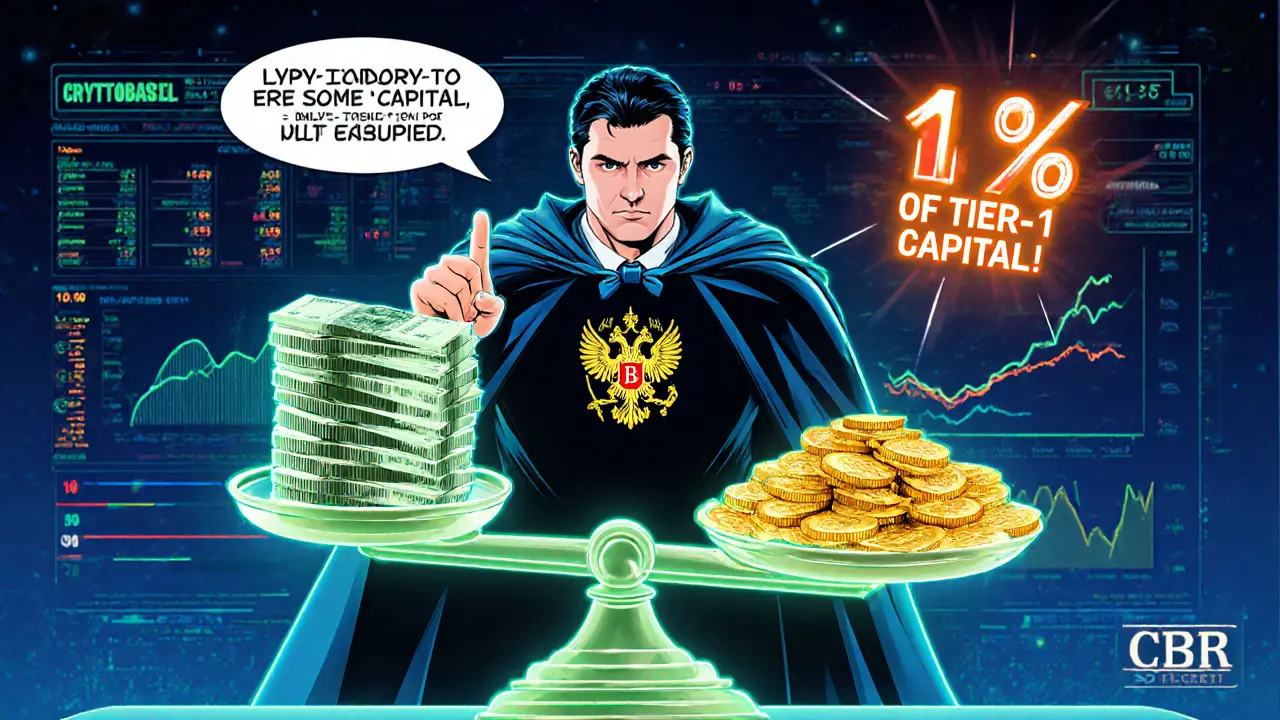Russian Crypto Regulation Compliance Checker
Regulation Overview
Dual-Track Approach
Allows crypto for international trade but bans domestic payments.
CurrentCryptoBasel Rule
Limits bank crypto exposure to 1% of capital from 2026.
Planned 2026Experimental Legal Regime (ELR)
Controlled sandbox for qualified investors only.
CurrentStablecoin Regulation
Draft rules expected by end of 2025.
Planned 2025TL;DR
- The Russian Central Bank crypto regulations follow a dual‑track model: limited crypto use for international trade, strict bans for domestic payments.
- From 2026 banks can only expose up to 1% of capital to crypto assets, a rule dubbed “CryptoBasel”.
- The Experimental Legal Regime (ELR) lets only “especially qualified” investors trade crypto under heavy KYC/AML supervision.
- Stablecoin rules are slated for final approval by end‑2025; they will align with international AML standards.
- All crypto service providers must join a state‑run monitoring platform or face blockage.
How the regulatory landscape has evolved
In the early 2020s the Russian Central Bank the central monetary authority of the Russian Federation, responsible for financial stability and oversight of payment systems dismissed cryptocurrencies as a threat. By 2024 that stance softened enough to allow digital‑currency payments in international trade, a move driven by sanctions pressure. The shift did not open the door for domestic use; instead, the bank built a “dual‑track” system that isolates experiment from everyday commerce.
Dual‑track approach: trade exception vs domestic ban
The trade exception, introduced in summer2024, permits firms to settle cross‑border invoices with crypto‑based tokens, provided the counterparties are outside Russia. This loophole satisfies companies looking for alternative settlement routes while keeping the ruble‑centric domestic system intact.
Simultaneously, the Experimental Legal Regime (ELR) a controlled sandbox that allows crypto activities only for investors meeting high financial thresholds was launched. Participation is limited to “especially qualified” investors-individuals or entities that can prove substantial net worth and sophisticated risk management. Anyone outside the ELR faces a blanket prohibition on crypto settlements, with penalties for violations.
Capital rules that will kick in in 2026
In May2025 the bank issued informational letter IN03‑23/87, outlining what analysts call “CryptoBasel”. The rule caps crypto‑related exposures at **no more than 1% of a bank’s capital** and forces banks to back every ruble of investor crypto funds with a ruble of their own capital. Andrey Tugarin founder of GMT Legal and commentator on Russian crypto policy describes the measure as a formalisation of existing conservative practice rather than a disruptive change.
From 2026 onward, any loan to a crypto firm must meet the 1% cap, and banks will have to report crypto‑related assets quarterly. The tighter requirement aligns Russian banking with BaselII/III/IV frameworks, hence the nickname “CryptoBasel”.
Compliance heavy‑weight: AML, KYC, and reporting
Compliance obligations are extensive. The CBR’s methodological recommendations demand:
- Robust AML systems that flag peer‑to‑peer (P2P) crypto trades.
- Mandatory KYC for every investor entering the ELR, with verification of source‑of‑wealth documentation.
- Reporting of any crypto transaction exceeding **600,000rubles** to tax authorities.
To enforce these rules, the bank cooperates with the Ministry of Digital Development government body overseeing digital transformation and cybersecurity in Russia on a digital de‑anonymisation platform. The system cross‑checks blockchain addresses against official identity databases, effectively turning anonymous wallets into traceable entities.

Stablecoin regulation - the next milestone
Deputy Finance Minister Ivan Chebeskov deputy minister responsible for fiscal policy and financial market regulation in Russia announced at the Moscow Financial Forum that stablecoin rules will be finalised by the end of 2025. The draft aligns Russian stablecoins with the FATF Travel Rule and requires:
- Full reserve backing in rubles or approved foreign currencies.
- Real‑time transaction monitoring and reporting.
- Licensing of issuers through the Central Bank’s supervisory framework.
While the Ministry of Finance pushes for a business‑friendly environment, the CBR remains firm on surveillance, hinting at inter‑agency tension over the balance between innovation and control.
Impact on banks, VASPs, and crypto businesses
All Virtual Asset Service Providers (VASPs) entities such as crypto exchanges, brokers, and wallet operators that facilitate the transfer of virtual assets must integrate with the state‑run monitoring platform or risk being blocked by Rosfinmonitoring. The anti‑money‑laundering agency Rosfinmonitoring Russia’s financial intelligence unit tasked with combating money laundering and terrorist financing is already drafting VASP licensing criteria that mirror the bank’s KYC/AML expectations.
For banks, the 1% exposure cap effectively forces most institutions to abandon direct crypto dealings unless they specialize in cross‑border trade. Crypto‑focused fintechs can still operate under the ELR, but they must meet stringent investor qualification standards and submit regular audit reports.
Future outlook - tighter control or gradual liberalisation?
Analysts see three possible trajectories:
- Consolidation under state control: the CBR could bring all crypto infrastructure-exchanges, wallets, stablecoin issuers-under a single supervisory body, making compliance uniform but restrictive.
- Selective easing for trade: given sanctions, the bank may expand the trade exception to include more token types, but still bar domestic payments.
- Stagnation: the current framework remains largely unchanged, with the 2026 capital rules being the last major tweak for the foreseeable future.
Given the political climate and the bank’s risk‑averse culture, the first scenario appears most likely. Expect continued investment in surveillance technology and tighter licensing for any crypto‑related activity.
Key regulatory elements - current vs. 2026
| Element | Current Status (2025) | Planned Status (2026) |
|---|---|---|
| Bank crypto exposure limit | Ad‑hoc limits; no formal cap. | Hard 1% of Tier‑1 capital per bank. |
| Stablecoin licensing | Draft proposals under review. | Full licensing regime with reserve backing. |
| ELR investor qualification | Qualified investors defined, but enforcement gradual. | Strict net‑worth thresholds enforced via CBR portal. |
| VASP integration | Voluntary reporting to Rosfinmonitoring. | Mandatory integration with state monitoring platform. |
| Transaction reporting threshold | 600,000rubles for tax reporting. | No change; reporting automated via digital platform. |
Quick guide for compliance officers
- Map all crypto‑related assets on your balance sheet and ensure they stay below the 1% ceiling.
- Verify that any VASP you partner with is registered with Rosfinmonitoring and feeds data to the state platform.
- Implement AML monitoring that flags P2P trades over 600kRUB and generate SARs (Suspicious Activity Reports) automatically.
- For stablecoin projects, secure full‑reserve backing and obtain the upcoming license before launching.
- Maintain an updated list of “especially qualified” investors if you operate under the ELR.

Frequently Asked Questions
Can Russian residents use crypto for everyday purchases?
No. Domestic crypto payments are prohibited outside the Experimental Legal Regime, which only allows transactions for qualified investors.
What does the 1% capital rule mean for banks?
From 2026 a bank can allocate at most 1% of its Tier‑1 capital to crypto‑related assets or loans. Any excess exposure must be reduced or re‑capitalised.
When will stablecoin regulations be finalised?
Deputy Finance Minister IvanChebeskov expects the rules to be approved by the end of 2025, with implementation early 2026.
Do VASPs have to join the state monitoring platform?
Yes. Rosfinmonitoring has announced that any VASP that does not integrate will be blocked from operating in the Russian market.
Is the Experimental Legal Regime open to foreign investors?
Only foreign entities that meet the same “especially qualified” criteria and register with the CBR can participate; otherwise they are barred.


Brooklyn O'Neill
May 30, 2025 AT 14:17Great breakdown of the new Russian crypto rules. The dual‑track approach definitely adds a layer of complexity for businesses.
Ciaran Byrne
June 2, 2025 AT 21:40Thanks for the concise overview.
Patrick MANCLIÈRE
June 6, 2025 AT 05:03The 1% capital cap for banks, often dubbed “CryptoBasel”, is more than just a numeric limit; it signals a strategic pivot in how Russian financial institutions will engage with digital assets. Historically, banks have treated crypto exposure as an ad‑hoc, loosely‑regulated activity, but the upcoming hard cap forces them to integrate crypto risk into their core capital planning. This means banks will need to dedicate a dedicated risk committee and potentially redesign their balance‑sheet reporting processes to isolate crypto‑related assets. For VASPs, the mandatory integration with the state‑run monitoring platform will likely increase operating costs, as they must invest in API development and compliance staffing. The draft stablecoin regulation adds another layer, demanding full reserve backing, which could push stablecoin issuers to lock up significant liquid assets. Moreover, the Experimental Legal Regime (ELR) restricts crypto activity to “especially qualified” investors – a classification that hinges on net‑worth thresholds and sophisticated risk‑management capabilities. This creates a two‑tier market: one for institutional players with deep pockets and another that is effectively shut out. The reporting threshold of 600,000 RUB for transactions also introduces a new data‑feed requirement for both banks and VASPs, compelling them to build or purchase AML analytics tools. From a broader perspective, these measures reinforce the Central Bank’s intent to monitor and control crypto flows while still allowing limited exposure for international trade. The dual‑track model, therefore, acts as a safety valve, letting export‑oriented firms settle cross‑border invoices in crypto without destabilising the domestic ruble ecosystem. Analysts predict that the 2026 rollout will be the last major regulatory shift for the foreseeable future, barring geopolitical shocks. In practice, compliance officers will have to map every crypto‑related line item on their ledgers, ensuring the aggregate stays below the 1% ceiling, or face regulatory sanctions. The state‑run monitoring platform, powered by Rosfinmonitoring, will likely evolve into a real‑time blockchain analytics engine, further eroding the anonymity that crypto traditionally offers. While the rules are stringent, they also provide a clear roadmap for businesses willing to adapt, offering a predictable regulatory environment compared to the previous years of ambiguity. Ultimately, the success of these policies will depend on how effectively the Central Bank enforces them and whether market participants can innovate within the defined boundaries.
Carthach Ó Maonaigh
June 9, 2025 AT 12:26Whoa, look at that fancy legal jargon – it’s like reading a bedtime story for accountants, except nobody’s snoring because the penalties are real!
Marie-Pier Horth
June 12, 2025 AT 19:49Ah, the grand tapestry of regulation! One can almost hear the solemn trumpets heralding the dawn of a new, orderly crypto era, where every token bows before the sovereign ruble.
Gregg Woodhouse
June 16, 2025 AT 03:12meh, same old stuff.
F Yong
June 19, 2025 AT 10:36Sure, let’s all trust the state‑run monitoring platform while we pretend our wallets aren’t being watched. *Eye roll*.
Sara Jane Breault
June 22, 2025 AT 17:59Looks like banks will need to keep crypto tiny and VASPs will have to play by the new rules good luck everyone
Lana Idalia
June 26, 2025 AT 01:22In the grand scheme of the universe, the 1% cap is but a speck of dust on the infinite canvas of financial destiny, reminding us that control is an illusion.
Henry Mitchell IV
June 29, 2025 AT 08:45Interesting take! :)
Kamva Ndamase
July 2, 2025 AT 16:08Let’s be real – these new rules are a wake‑up call. If you’re not ready to comply, you’re already out.
bhavin thakkar
July 5, 2025 AT 23:31Behold! The stage is set, the protagonists are the banks and VASPs, and the drama of regulation shall unfold with thunderous applause.
Thiago Rafael
July 9, 2025 AT 06:54In accordance with the Central Bank’s recent directives, it is imperative that all financial entities rigorously adhere to the stipulated 1% exposure limit and integrate with the mandated monitoring infrastructure, thereby ensuring systemic stability and regulatory compliance.
dennis shiner
July 12, 2025 AT 14:17Nice summary. :)
Krystine Kruchten
July 15, 2025 AT 21:40Appreciate the thoroughness; this will help compliance teams navigate the upcoming changes with confidence.
Mangal Chauhan
July 19, 2025 AT 05:03Thank you for outlining the requirements so clearly; it is essential that institutions update their policies accordingly and ensure full integration with the state‑run platform. 📊💼
Darius Needham
July 22, 2025 AT 12:26The 600,000 RUB reporting threshold will definitely increase data‑collection burdens for VASPs, but it also creates a more transparent ecosystem.
WILMAR MURIEL
July 25, 2025 AT 19:49Considering the myriad of compliance obligations now imposed-ranging from capital caps, mandatory integration with a state‑run monitoring platform, rigorous AML/KYC protocols, and the looming stablecoin licensing regime-it becomes evident that financial institutions and crypto service providers alike must not only allocate substantial resources toward regulatory technology investments but also cultivate an internal culture of continuous oversight, wherein compliance officers regularly audit exposure levels, ensure that every transaction above the prescribed threshold is reported without delay, and maintain an up‑to‑date ledger of investor qualifications to meet the Experimental Legal Regime’s stringent criteria, all while navigating the broader geopolitical pressures that have shaped the Central Bank’s cautious yet progressive stance on digital assets.
carol williams
July 29, 2025 AT 03:12From a formal standpoint, the dual‑track approach epitomizes a calibrated response to sanctions, allowing cross‑border crypto settlements while safeguarding domestic monetary sovereignty.
Andrew McDonald
August 1, 2025 AT 10:35One might argue the over‑regulation stifles innovation, yet history shows that clear frameworks eventually foster sustainable growth. :)
Ally Woods
August 4, 2025 AT 17:58Looks like another set of rules to deal with.
Kristen Rws
August 8, 2025 AT 01:22Yay, new rules means we can all be sures! Optimistic about the future.
Fionnbharr Davies
August 11, 2025 AT 08:45Thoughtful analysis; the balance between control and innovation will be the true test for the Russian crypto ecosystem.
Narender Kumar
August 14, 2025 AT 16:08In the grand theater of financial policy, this latest act is both a triumph of order and a lament for liberty.
Nilesh Parghi
August 17, 2025 AT 23:31From a philosophical lens, the regulation reflects society’s attempt to reconcile freedom with security.
Keith Cotterill
August 21, 2025 AT 06:54One must, with utmost clarity, recognize that these regulatory frameworks, while ostensibly protective, are fundamentally designed-yes, designed-to consolidate national financial sovereignty and curb external influence; this is neither accidental nor benign!!!